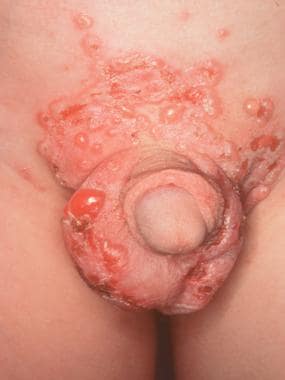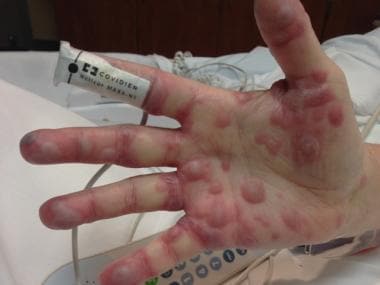Background
Linear immunoglobulin A (IgA) dermatosis (LAD) is an autoimmune subepidermal vesiculobullous disease that may be idiopathic or drug-induced. Children and adults are affected, with disease of the former historically referred to as chronic bullous dermatosis of childhood. The clinical presentation is heterogeneous and appears similar to other blistering diseases, such as bullous pemphigoid and dermatitis herpetiformis. Examples are shown below.
Pathophysiology
Linear IgA dermatosis is an autoimmune disease histopathologically characterized by the linear deposition of IgA at the basement membrane zone (BMZ). Antibody deposition leads to complement activation and neutrophil chemotaxis, which eventuates in loss of adhesion at the dermal-epidermal junction and in blister formation. Disease in children is immunologically identical to that of adults. The mechanism of loss of self-tolerance to target antigens is unknown.
Within the dermal-epidermal junction, different antigenic target sites, including the lamina lucida, the sublamina densa, or both locations simultaneously, have been identified. The best-characterized antigen is a 97-kd protein extracted from human epidermis that binds IgA antibodies from sera of patients with linear IgA dermatosis. Sera that binds the 97-kd antigen localizes to the lamina lucida of salt-split skin. Originally thought to be a unique protein of the lamina lucida, further research reveals that the 97-kd protein may represent a portion of the extracellular domain of the 180-kd bullous pemphigoid antigen (BPAg2). [1]
The same patient sera have been shown to bind a 120-kd antigen in the BMZ. The 97- and 120-kd antigens may represent cleaved fragments of BPAg2, which exist as such in vivo or are produced by proteolytic digestion in vitro. These smaller molecules could also be alternative splicing products of the same BPAg2 gene. Because antibodies that bind the 97- and 120-kd antigens do not recognize the 180-kd BPAg2, the former may express unique epitopes distinct from those of the parent protein.
A case series reported patients with sera not reactive against the 97-kd antigen but rather against both bullous pemphigoid antigens. Of 11 patients, a 230-kd antigen (BPAg1) was recognized in 6 patients and BPAg2 was recognized in 5 patients. The authors suggest that an IgA-specific immune response may occur against bullous pemphigoid antigens in linear IgA dermatosis. These results are provocative given that the 97-kd linear IgA dermatosis antigen may represent a portion of the extracellular domain of BPAg2.
A 285-kd target antigen has been identified in the lamina lucida and the sublamina densa; this antigen is recognized by circulating antibodies in some patients with linear IgA dermatosis, but it has not been further characterized.
A 250-kd dermal antigen corresponding to collagen VII of anchoring fibrils has also been reported as a target antigen in some patients.
Some patients possess IgA and IgG antibodies toward laminin 332 in what Zone et al described as linear IgA/IgG bullous dermatosis. [2, 3] Additionally, subunits of laminin 332 have been the targeted antigen in vancomycin-induced linear IgA dermatosis. [4] Antilaminin 332 antibodies are typically seen in malignancy-associated mucous membrane pemphigoid (MMP).
The etiology underlying drug-induced linear IgA dermatosis remains elusive but is speculated to be caused by an immune response towards a drug-derived hapten-protein antigen. As with its spontaneous counterpart, the antigen is highly variable.
Linear IgA dermatosis illustrates the importance of identifying the target antigen. In cases in which type VII collagen is the molecule against which the antibody response is directed, patients are less likely to be responsive to treatment. Thus, viewing this condition as a subset of epidermolysis bullosa acquisita is better. Similarly, patients with antibodies directed against the bullous pemphigoid antigens may be classified as having bullous pemphigoid but with an IgA response rather than an IgG response; those with antibodies towards laminin 332 may potentially have mucosal involvement. Until more patients are reported whose antibody response is detailed to the molecular level and until this definition becomes clinically available, these heterogeneous patients will continue to be grouped into a single category, linear IgA dermatosis.
Etiology
The list of agents implicated in linear IgA dermatosis continues to grow, especially with regard to medications. Many patients report prodromal events, such as illnesses or ingestion of drugs. In absent large series or a preponderance of case reports, only a subset of cases have identifiable causes. Gluten-sensitive enteropathy is not associated with linear IgA dermatosis. Various causes are discussed.
Seventeen case reports have implicated vancomycin in linear IgA dermatosis. Of all reported causative drugs, it is the best-documented agent in the literature. [5] Vancomycin-loaded bone cement has even been described to protract linear IgA dermatosis. [6, 7] Other potential triggers and include the following: amiodarone, ampicillin sodium, captopril, cefamandole nafate, cyclosporine, depot sulfonamide, diclofenac, [8] glibenclamide, interferon gamma and interleukin 2, iodine contrast agent, lithium carbonate, penicillin sodium, phenytoin sodium, somatostatin, sulfamethoxazole/trimethoprim, sulfisoxazole, topical sodium hypochlorite (1), moxifloxacin, amoxicillin-clavulanate, and vigabatrin. Infliximab was described as a cause of linear IgA dermatosis and may represent a paradoxical autoimmune reaction similar to that seen in antitumor necrosis factor agent‒induced psoriasis. [9] Immunotherapy treatment regimens have been documented to cause several subtypes of immunobullous disease, including linear IgA dermatosis. [10]
The development of linear IgA bullous dermatosis has been reported following influenza vaccination in a 54-year-old woman. [11]
Preceding illnesses, such as typhoid, brucella, tuberculosis, antibiotic-treated tetanus, varicella, herpes zoster, Paecilomyces lung infection, gynecologic infections, and upper respiratory infections, have all been reported in association with linear IgA dermatosis. The significance of these associations is uncertain. Their potential role in stimulation of the IgA mucosal system has yet to be elucidated.
Linear IgA dermatosis associated with malignancy has been reported in as many as 5% of cases. Lymphoproliferative malignancies, specifically Hodgkin disease, non-Hodgkin lymphoma (eg, following stem cell transplantation), [12] chronic lymphocytic leukemia, and angioimmunoblastic T-cell lymphoma have been described. [13, 14] Linear IgA dermatosis has also been reported with solid tumors, such as bladder carcinoma. Other associated malignancies include polycythemia rubra vera, plasmacytoma, multiple myeloma, ocular melanoma, squamous cell carcinoma of the esophagus, breast carcinoma, uterine carcinoma, eccrine carcinoma, metastatic squamous cell carcinoma, colon carcinoma, thyroid carcinoma, retroperitoneal carcinoma, metastatic hypernephroma, pancreatic carcinoma, and hydatidiform mole. The validity of the association between linear IgA dermatosis and malignancy remains to be proven.
Because linear IgA dermatosis is itself an autoimmune disease, an association with other such disorders is interesting despite proven causality. Cases have been described in association with systemic lupus erythematosus, dermatomyositis, rheumatoid arthritis, polymyalgia rheumatica, hypothyroidism, chronic hepatitis, Crohn disease, ulcerative colitis, multiple sclerosis, acquired hemophilia, and IgA nephropathy. Again, these associations may be coincidental.
Linear IgA dermatosis in children has been reported in association with human leukocyte antigen B8 (HLA-B8), but the significance of this finding is unknown.
Pancreatic lipase deficiency has been reported once in association with linear IgA dermatosis.
Epidemiology
Frequency
United States
The prevalence of linear IgA dermatosis in Utah has been estimated as 0.6 per 100,000 adults. The prevalence in children has not been reported.
International
The incidence of adult linear IgA dermatosis in southern England has been estimated to be 1 case in 250,000 population per year. The incidence in France has been reported as 0.13 in 250,000 population. [15] A 32-year retrospective study from Tunisia noted that linear IgA dermatosis is the most common autoimmune bullous disease in children in Tunisia; it reportedly occurs commonly in preschool-aged boys. [16]
Sex
Some case series have reported a slight female preponderance; the female-to-male ratio is 1.6:1.
Age
Linear IgA dermatosis has a bimodal age of onset. Disease in children commences at ages ranging from 6 months to 10 years, with a mean of 3.3-4.5 years based on two case series. Disease of adults ranges from 14-83 years, with a mean of 52 years. Disease is most common in the nonreproductive years. Drug-induced disease is more likely to occur in the older population because this group is often being treated for multiple medical conditions.
Prognosis
The mean duration of idiopathic linear IgA dermatosis of childhood is 3.9 years, ranging from 2.1-7.9 years. Remission has been reported to occur in 64% of children, in most cases within 2 years. Disease of adults is more protracted, with a mean duration of 5.6 years, lasting anywhere from 1-15 years. The remission rate in adults is less than that in children (48%). The disease tends to wax and wane in severity. Drug-induced cases typically resolve quickly once the causative agent is identified and withdrawn. However, a recent study comparing spontaneous versus drug-induced linear IgA dermatosis found the latter to be more severe, with larger erosions, sometimes mimicking toxic epidermal necrolysis. [17] Cutaneous lesions usually heal without scarring.
Lesions of the mucous membranes heal with scarring and pose considerable morbidity. Desquamative gingivitis may secondarily damage teeth. Ocular linear IgA dermatosis may be indistinguishable from cicatricial pemphigoid and lead to blindness. [18] Involvement of the pharynx, the larynx, the nose, the rectum, and the esophagus has been reported.
A retrospective study of 12 women with linear IgA dermatosis showed improvement during pregnancy, usually by 10 weeks' gestation. Improvement was most marked in the third trimester. The most common agent used for treatment of linear IgA dermatosis is dapsone, which is classified as pregnancy class C (uncertain safety; animal studies show an adverse effect, no human studies) by the US Food and Drug Administration. In this series, the authors observed no serious adverse effects from dapsone during 11 pregnancies. Postpartum relapses of linear IgA dermatosis were common, occurring in 1 case within 2 hours. The range of time to relapse for the remaining 11 patients was 1-6 months, with 3 patients achieving complete remission at 2 years. Fetal outcome was unaffected by the disease. [19]
-
Annular lesions demonstrating the string of beads sign.
-
Bullous lesions on the genital area in a child with linear IgA dermatosis.
-
Persons with linear immunoglobulin A (IgA) dermatosis may present with prominent ocular signs and symptoms.
-
Neutrophilic microabscesses in linear immunoglobulin A (IgA) dermatosis.
-
Bullous lesions of the palmar surface in an elderly man with vancomycin-induced linear immunoglobulin A (IgA) dermatosis.





